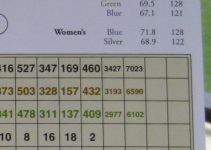Golfstead is reader-supported. When you buy through links on the site, we may earn an affiliate commission at no extra cost to you. Our affiliations include, but are not limited to, the eBay Partner Network and Amazon Associates.

Whether you want to hit a power draw down a gentle dogleg or stay away from trouble on your approach shot, a draw is a coveted shot in golf and a major asset to have in your arsenal. Unfortunately, it’s also a shot that most golfers don’t know how to hit.
Read on to understand how to hit a draw with a driver, wood, or iron; the underlying concept is the same for each club.
What is a draw?
A draw is a shot that curves gently from right-to-left for a right-handed golfer.
Draws tend to go farther than fades. This is because draws usually involve “turning over” the club at impact which de-lofts it slightly, resulting in a stronger ball flight with less spin and more rollout.
In addition to draws going farther, many would argue that the shape of a draw just looks better too.
To be more specific, a golf ball that starts right and draws back left is a push-draw, a ball that starts straight and draws is a straight draw, and a ball that starts left and draws is a pull draw.
Hitting A Draw
To hit a draw, your clubface needs to be slightly closed at impact relative to your swing path. There’s really nothing more to it than that.
When you achieve this, it imparts a sidespin on the ball that causes it to curve to the left for a right-handed golfer (or to the right for a left-handed golfer, as in the image below).

Most amateurs tend to leave their clubface open at impact and hit fades or slices rather than draws.
There are several techniques that you can employ to produce the draw shot shape. I will discuss three of them below.
Keep in mind that some of these may not work well or be convenient for you. You will need to find something that works best for you depending on your body type and swing.
Method #1: Change your alignment.
Perhaps the most commonly used method is to aim your feet and shoulders right of your target and point your clubface directly at the target. Then, regrip.
If your swing path matches your alignment, you should deliver the clubface to the ball in a slightly closed position, which will cause your ball to draw towards the target.
World-renowned golf instructor Butch Harmon recommends making a smoother swing through impact as this makes it easier for the club to release and impact the ball in a square or slightly closed position.
It’s worth noting that physics dictates that the direction the golf ball starts is almost entirely dependent on the direction the face is pointing at impact. This means that if you align 12 degrees right and your clubface is pointed at the target, the ball will start only about 2 degrees to the right.
For this reason, if you find that your draws produced with this method are curving past the target line, we recommend pointing the clubface slightly right of target (while still aligning even farther right) so that the ball starts in the correct direction.
Method #2: Adopt a strong grip.

With a strong grip, you will be able to “turn over” the club more easily and deliver the clubface in a relatively closed position. This is because the momentum of a strong grip encourages a release of the club through impact.
Be sure to aim (align) right if you intend to hit a straight draw, and avoid turning the club over too much or you will produce an undesired hook.
Method #3: Swing in-to-out.
This method of drawing the golf ball is most common among professional golfers that play at the highest level. It’s also the most difficult to pull off if you don’t have complete command of your swing.
Swinging in-to-out is the opposite of coming “over the top” which is the most common cause of slices. It involves shifting your hands closer to your body during the backswing and “pushing” out across the ball through impact.
If you keep the clubface square at impact, the result is a shot that starts right of the target and curves back towards it. This means that you don’t have to change your alignment to hit the draw.
Having said that, swinging in-to-out can make it difficult to keep the clubface from impacting the ball in an open position which would be quite disastrous — this is why we recommend using a strong grip for this method.
Some Tips
If you have trouble releasing the club and delivering the face to the ball in a closed position, try loosening your grip.
Or, as Jack Nicklaus himself suggests, try forming a mental image of the toe of the club moving ahead of the heel through impact (the club would be in a closed position when this occurs).
As mentioned above, the goal is to strike the ball with the clubface in a slightly closed position relative to the swing path. How exactly that is done is up to the individual golfer, but there are ways to do it that are widely considered to be relatively easy and straightforward.
What equipment is best for the job?
There are other things you can do to make the process of hitting a draw much easier. One of them is using quality adjustable drivers, woods or hybrids that allow you to alter the weight distribution of the clubhead and make it easier to hit a draw.
Adding draw bias to a driver typically involves putting more weight in the heel area closer to the hosel. This helps the toe of the driver stay ahead of the heel through the swing, promoting a closed face at impact.
They are well worth the investment and will enable you to have a more enjoyable experience on the course for years to come.
Some excellent club manufacturers to consider are Callaway, TaylorMade, Cobra and Bridgestone. Check out our club reviews for some of the latest and greatest models.
Conclusion
Draws can be quite difficult for many recreational and high-handicap golfers to hit. In fact, fades are much more common because many amateurs tend to come over the top.
However, with the right technique and some practice, draws are definitely achievable.
Now, if you’ve tried to perfect your draw and continue to struggle with it, check this out.
This is going to get you the ideal golf body, and as a consequence, allow you to shape your shots as you please (draws, fades, etc.), give you longer, straighter drives, and make you a very consistent golfer:
Thanks for reading. Can you hit a draw on demand? Feel free to drop any questions or feedback in the comment section below.





Ha, hitting a draw to impress some friends is so true. But usually I do a draw on accident and then of course act like I did it on purpose 🙂 Before reading your post I think I thought I knew how to do a draw but now its much more clear. I’m going to true out your methods next time I’m at the driving range…I’m sure its going to take some practice. Thanks for the help!
Hello Paul,
Thank you for a detailed article on how to hit a draw. I am a beginning golfer and I have so much to learn. Your instructions are of great value and I will try these techniques when I get a little more skill under my belt. I will send a link of this page to my brother also. He loves golf and I know he will find this page of great value. As a beginning golfer, what is the best tip you can give me to help me work on my game? Thanks again for this great article.
Hi Val,
I’m glad you find the article valuable, and I hope you brother does too. I wouldn’t consider myself an expert on the golf swing, but what worked for me, and what I think is good advice is:
– make sure you have a good grip and posture first (I will expand on these things in future articles, but you can find the relevant info online)
– keep your eye on the ball until you hit it
– start out by making shorter, smooth swings and focus on making solid contact with the ball with a square clubface
– once you start making consistently good contact with the ball, you can build up to a fuller swing
This just scratches the surface of course, and there’s so much more to learn for a golfer who wants to get good. The tips on this website probably won’t turn the average hack into a pro, but they are laid out in a convenient and (hopefully) straightforward manner and I hope that helps people take some value out of it.